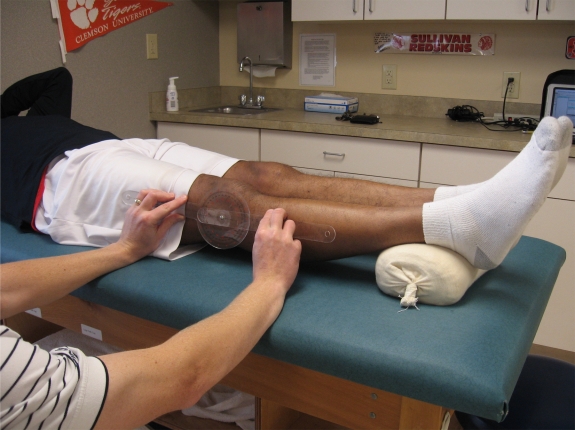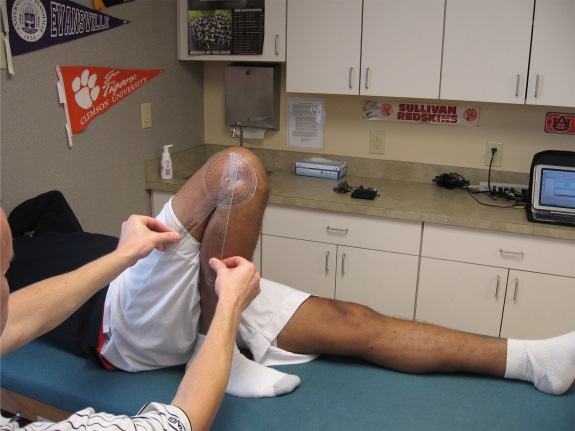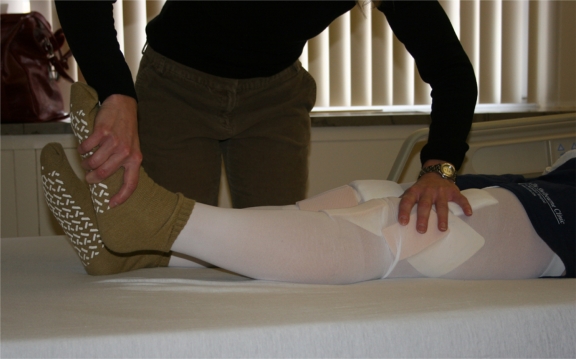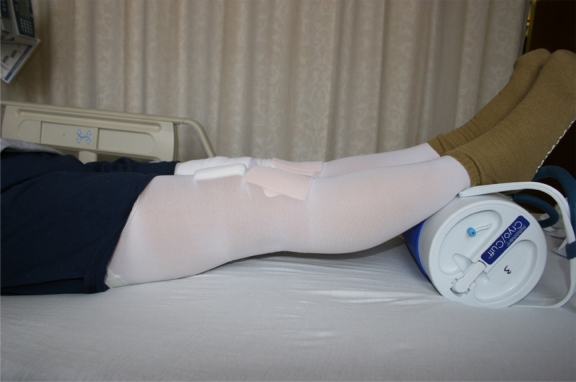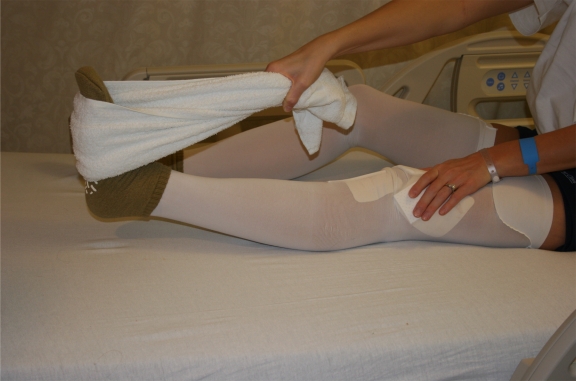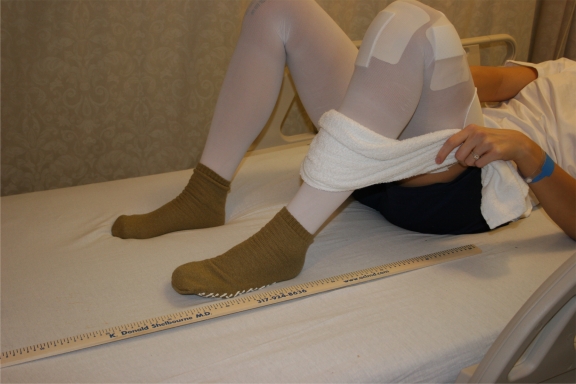Abstract
This clinical commentary outlines a new clinical model for anterior cruciate ligament (ACL) rehabilitation, the Knee Symmetry Model. This model has been developed by clinical observation, patient interaction, and by analyzing outcome measures derived from prospective follow-up of patients. More specifically, the best outcome scores occurred in patients with symmetric range of motion and strength. A thorough discussion of the details involved in the development and implementation of this rehabilitation program for this patient following ACL reconstruction is described. Included in this description is the supporting evidence and clinical rationale behind pre-operative and post-operative ACL rehabilitation. Preliminary results from a recent group of patients are presented. When using the Knee Symmetry Model 100% of patients achieved normal knee extension and 97% of patients achieved normal knee flexion.
Keywords: ACL rehabilitation, pre-operative rehabilitation, post-operative rehabilitation
INTRODUCTION
Rehabilitation of patients following anterior cruciate ligament (ACL) surgery has evolved dramatically over the last several decades. During this time, clinicians have gradually changed their approach from absolute immobilization and no muscle activity to minimal range of motion (ROM) restrictions with immediate muscle activation following surgery.1–8 Although ACL post-operative rehabilitation has continued to evolve, relatively minimal literature is available outlining the precise nature of ACL rehabilitation. The authors of this report have focused their clinical practice entirely on knee injuries and, through this focus, have developed a new model for ACL rehabilitation, the Knee Symmetry Model.
Current articles on ACL rehabilitation are few or lack the proper detail necessary for a practicing clinician to fully implement the rehabilitation program. Even those articles where rehabilitation is the primary focus of the study do not give full descriptions of the details involved with ACL rehabilitation.1,3,4,6,7 Therefore, clinicians are left with insufficient detail when attempting to implement a rehabilitation program outlined in the literature. More specifically, most articles in the current literature focus on the details involved with strength training while ROM is not focused upon.1,7 Through research and data collection, ROM appears to be the primary issue involved in excellent outcomes following ACL reconstruction. To date, other articles within the literature are infrequent that specifically focus on the ROM part of the rehabilitation process.
The authors have been able to develop the Knee Symmetry Model for ACL rehabilitation in part due to the utilization of the same graft with the same surgical approach and the same graft fixation for the past 25 years. Therefore, because the surgical procedure has been constant, the primary variable observed in patient outcomes is the rehabilitation. The surgical procedure used in this center is an ACL autograft with bone-patellar tendon-bone. While most surgeons have changed their surgical procedure, this center has maintained the same graft source, the same graft fixation, and the same surgical approach, thus, allowing changes in patient outcomes to be observed as a result of changing the rehabilitation program. Given that the graft source, fixation, and surgical approach have not changed, the focus has been on refining the rehabilitation program.
Outcomes have helped identify that patients who achieve symmetrical ROM and strength have better subjective and objective outcomes, regardless of meniscal or articular cartilage damage found at the time of surgery.9 Physical therapists do not have control over the surgeon or patient's choice of graft selection, but do play an important role in the patient's ability to achieve symmetrical ROM. Understanding the importance of symmetrical ROM makes it the most important factor in the rehabilitation process, regardless of graft choice or the surgical procedure. The Knee Symmetry Model provides an outline to achieve this goal of full ROM. The goal of the rehabilitation program should be symmetrical ROM and the surgical procedure performed should allow the physical therapist the best opportunity to restore the patient's knee to symmetrical ROM and strength. Although the basic principles of rehabilitation outlined in this report apply to all grafts, the specific details of rehabilitation along with the outcomes reported are based on the knee symmetry model following an ACL reconstruction performed with a patellar tendon graft.
SURGICAL APPROACH
Both contralateral (CBPTB) and ipsilateral (IBPTB) bone patellar bone ACL autografts are utilized in this center. The CBPTB and IBPTB surgical procedures have been described in depth elsewhere.10,11 The CBPTB can be used as a primary procedure or to revise a previous ipsilateral reconstruction. Critical elements of the CBPTB and IBPTB surgical procedures include proper graft placement in the tibial and femoral tunnels, full knee ROM (hyperextension and flexion) after the graft has been placed and tensioned in the tibial and femoral tunnels, and accommodative fixation (sutures tied over buttons) of the graft in the tibial and femoral bone tunnels. The graft needs to be tight enough to provide stability but loose enough to allow for full knee ROM in the operating room. If the knee is not able to go through a full ROM once the graft is tensioned, post-operative rehabilitation programs designed to restore symmetric ROM may result in decreased knee stability or leave the patient with the inability to achieve symmetrical ROM. Therefore, the authors recommend a thorough discussion with the referring surgeon when implementing this program.
REHABILITATION PHILOSOPHY
As our knowledge of the patient's response to this surgery has grown, an increased emphasis has been placed on restoring the surgical knee to the pre-injury status.8,10 To fully accomplish this goal, the clinician is asked to restore bilateral knee symmetry. Most clinicians believe that early elimination of pain and inflammation in the injured knee is critical to achievement of knee symmetry in patients. However, the rehabilitation approach should also include bilateral knee symmetry in terms of ROM, strength, stability, and function as soon as symptoms allow. Principles of treatment begin pre-operatively and continue until complete knee symmetry is achieved post-operatively. Once knee symmetry is achieved postoperatively, the patient is discharged from formal rehabilitation; however, each patient is followed closely after discharge from formal rehabilitation. It is only through patient follow-up that the long-term results of surgery and rehabilitation have been observed and rated. Failure to perform follow-up evaluations on patients leads to an inaccurate understanding or a misinterpretation of results.
Therefore, our rehabilitation philosophy has been shaped by frequently analyzing the patient's post-operative status. Each and every patient is strongly advised to follow up on regular intervals including 1, 2, 4, and 6 months and at the first, second, fifth, tenth, and twentieth year post-operatively. This information is entered into the center's database so that all patient outcomes can be analyzed together. The understanding gained from the long-term follow up of patients has guided the establishing principles of rehabilitation within this program. This program has developed based on long-term research and data collection that recognizes the importance of obtaining knee symmetry, most importantly symmetrical ROM, as a means to provide the patient with optimal short and long-term outcomes.
PRE-OPERATIVE REHABILITATION
Patients are evaluated by the physician and physical therapist at the time of their initial appointment. The physician makes the medical diagnosis, and the physical therapist performs an initial examination by observing and measuring all elements of knee symmetry. Patients are taught a home rehabilitation program for each component of the knee symmetry model. Although an emphasis on a home program requires fewer visits to physical therapy, each visit is quite comprehensive. Emphasis is placed on educating patients and their families about the goals of rehabilitation. The primary goal, knee symmetry, is stressed repeatedly during the pre-operative period. Once the patient has achieved the specified goals and is able to demonstrate the ability to perform the exercises, they are approved for surgery.
Patients are required to reduce the inflammation and swelling in the involved limb prior to surgery. They are instructed to utilize ice, compression, and elevation 3–4 times per day until the inflammation and swelling are eliminated. During the pre-operative period patients are instructed to refrain from competitive sports; however, they are not specifically restricted from their normal daily activities.
Restoring complete passive ROM pre-operatively is a key to the entire rehabilitation program. Included in the knee ROM is bilaterally symmetric motion, which, in most patients, includes a component of hyperextension and knee flexion. Passive knee extension is measured with the patient lying supine with the heel propped on a bolster to allow the knee to fall into hyperextension (Figure 1). Passive knee flexion is also measured in supine (Figure 2). Both a quantitative (measurement) and qualitative (end feel) approach is utilized for assessment of motion. Measurement is performed and recorded in a hyperextension/extension/flexion format.11 If a patient has 5 degrees of hyperextension and 135 degrees of flexion their measurement is recorded as 5/0/135. If a patient has lost 5 degrees of extension from 0 degrees neutral, the measurement is recorded as 0/5/135. Likewise, the end feel for hyperextension is observed quite meticulously by the physical therapist (Figure 3). It is not until both the end feel and the measurement of hyperextension are symmetrical that surgery is an option. Each physical therapist has performed a reliability test for both knee extension (hyperextension) and knee flexion. Previously the authors reported interrater intra-class correlation (ICC) values for knee extension (.88) and flexion (.99) and intrarater reliability for knee extension (.95) and flexion (.99).12
Figure 1.
Knee hyperextension measurement
Figure 2.
Knee flexion measurement
Figure 3.
Knee hyperextension (end feel)
As the inflammation, swelling, and knee ROM are improved, neuromuscular re-training is initiated pre-operatively. Patients are taught leg control activities like quad sets and leg raises, and instructed how to walk with a normal gait pattern. Patients may resume low impact activities and weight training if they desire, but these activities are not required pre-operatively. Before surgery, each patient is tested for quadriceps and hamstring muscle strength isokinetically at 60° and 180° per second. Both single leg hop and unilateral leg press are measured preoperatively and used as post-operative strength goals as well. The strength measures obtained on the uninjured knee are utilized as a post-operative goal for both knees.
Knee function is measured with both the modified Noyes and International Knee Documentation Committee (IKDC) subjective outcome instruments.13 Each patient is given these instruments pre-operatively and at regular intervals post-operatively.
IMMEDIATE POST-OPERATIVE REHABILITATION
When CBPTB surgery is performed, both knees of the patient must be addressed in the rehabilitation process. Although a rehabilitation program must be applied to each patient's knee, the goals for each knee are somewhat different. On the graft-donor knee (contralateral knee), ROM is easily achieved and allows the clinician to focus on strength within the first 1–2 days post-operative. While on the ACL-reconstructed knee (ACL injured knee) the focus is on ROM, not strength. By performing surgery in this manner, the rehabilitation clinician is able to concentrate on the most important goals for each knee and minimize the post-operative complications. It is only through the process of performing surgery and rehabilitation on BOTH knees that the importance of goals and expectations for the two types of surgery (the ACL reconstruction and the graft-donor site) have been more completely understood. The rehabilitation program for each knee will now be outlined in detail.
ACL-Reconstructed Knee (ACL Injured Knee) - CBPTB or IBPTB
General Guidelines
During the immediate post-operative period, patients are hospitalized overnight to assure proper pain and swelling control is obtained. Patients are given ketoralac intravenously, placed on a continuous passive motion (CPM) machine, and provided with a cold/compression device (Cryocuff TM , DJ Orthopaedics, Vista, CA).
Ketoralac, a prostaglandin inhibitor, is used both pre-operatively and post-operatively. Patients are given 30mg intravenously pre-operatively and started on a continuous drip post-operatively. The continuous drip consists of 90 mg of ketoralac in 1L of normal saline solution over a 23-hour period. Ketoralac is combined with a local injection of .25% Marcaine and, when combined with the ketoralac, provides patients with excellent post-operative pain relief.14 A thin waterproof dressing is applied over the incision sites and drains are placed in bilateral knees for the first 23 hours to help minimize a hemarthrosis. Thromboembolitic compression stocking are placed on both legs and worn during the first week of bedrest. A cold/compression device is also immediately initiated in the operating room and utilized continually for the first week post-operatively.
The patient's ACL-reconstructed knee is placed in a CPM machine immediately after surgery. The primary purpose of the CPM machine is to elevate the knee above the level of the heart to help minimize post-operative swelling. Secondarily, the CPM machine provides gentle passive ROM to the ACL-reconstructed knee and is set to move from 0–30 degrees of knee flexion continuously throughout the first week after surgery. The patient is instructed to remain supine with the leg elevated and placed in the CPM continuously during the first week after surgery.
Throughout the first week after surgery the patient is placed on bed rest with bathroom privileges in order to minimize swelling and maximize ROM. The avoidance of activity is an important, but a misunderstood concept developed after the initial “Accelerated Rehabilitation after ACL Reconstruction” article in 1990.8 The authors believe that bed rest during the first week post-operatively allows the patient to more readily achieve the post-operative goals for each knee. More specifically, bed rest decreases swelling in the patient's ACL-reconstructed knee allowing for a much quicker return of ROM. Patients are instructed to have a caregiver in place to reduce their overall activity level and permit the patient to focus on their rehabilitation during the first week post-operatively. This plan, when strictly adhered to, greatly diminishes the amount of inflammation and swelling in either knee, which facilitates an earlier restoration of knee symmetry.
Range of Motion
Immediately after surgery and while in the hospital, the patient is asked to initiate ROM activities for hyperextension and flexion four times per day. Knee hyperextension is obtained via heel prop exercises (Figure 4), towel stretch exercises (Figure 5), and active hyperextension (Figure 6) while knee flexion activities during this period include active and active-assisted heel slide exercises (Figure 7). Goals for discharge from the hospital include symmetrical knee hyperextension and 125 degrees of knee flexion. It is important to emphasize that ROM is unlimited during the initial phase of rehabilitation post-operatively. The only limit on obtaining symmetric ROM is patient tolerance. Most patients lose some of their initial ROM after they are discharged. However, the psychological effect of knowing near full ROM has been achieved immediately post-operatively is helpful in obtaining full ROM.
Figure 4.
Heel props
Figure 5.
Towel stretches
Figure 6.
Active hyperextension
Figure 7.
Heel slides
Strength
Following surgery, strength training for the ACL-reconstructed knee is not formally emphasized. Too frequently, an aggressive strengthening program for the patient's ACL-reconstructed knee leads to increased inflammation and loss of ROM, which is counter productive. However, proper quadricep muscle activation is emphasized in order to have good leg control for ambulation. This quadriceps muscle activation is achieved through quad set exercises and active hyperextension. The same program is followed for both the CBPTB and IBPTB surgical procedures.
Graft-Donor Knee (Contralateral Knee)
Range of Motion
When a CBPTB procedure is performed, both of the patient's knees must be rehabilitated. During the initial post-operative period ROM in the graft-donor knee is addressed by the same methods utilized on the patient's ACL-reconstructed knee. Knee hyperextension activities (heel prop, towel stretch, active hyperextension) are performed along with heel slide exercises for knee flexion several times per day.
Strength
The patient's graft-donor knee easily achieves normal ROM. Due to the nature of the graft harvest procedure, no effusion occurs in the graft-donor knee which allows for an easier restoration of ROM. Once normal ROM has been achieved on the graft-donor knee, focus is placed on tendon regeneration during the immediate post-operative period. Beginning on the day after surgery each patient performs resisted leg press activities on the graft-donor knee. A unilateral leg press machine (SHUTTLE, Contemporary Design Company, Glacier, WA) adapted for in-bed resisted activity is utilized for the first two weeks post-op (Figure 8). Patients are taught to perform up to 100 repetitions with 7 pounds before increasing resistance on the leg press machine. Leg press activities are performed four times per day during this period. Patellar tendon discomfort is expected due to the active work performed by the patellar tendon. However, patients are cautioned to avoid ROM loss at the expense of patellar tendon strengthening. Early patellar tendon hypertrophy can be observed and is encouraged with these patients.
Figure 8.

Unilateral leg press
Both Knees - Function
Patients are instructed to remain supine with the ACL reconstructed leg elevated in order to minimize swelling. The patient may shower and have restroom privileges. Gait is evaluated on the second day and patients are instructed to ambulate full weight bearing with proper weight shift and heel strike. It is rare for a patient to be unable to perform this, however, if the patient is having difficulty with quadriceps activation and is unable to safely bear his/her weight, he/she is given an appropriate assistive device. However, most all patients are able to begin ambulating without an assistive device day two post-operatively. Bathroom privileges are available to the patient for the first week after surgery, but ambulation or standing for long period is strongly discouraged.
INTERMEDIATE POST-OPERATIVE REHABILITATION
Following the immediate post-operative phase of rehabilitation, an intermediate phase is implemented. During this phase the goals are to rehabilitate both knees of the patient symmetrically to their pre-operative values. No time lines are used for achievement of these goals. Each patient is progressed according to his or her own healing progression. Once inflammation and swelling have been eliminated and full symmetrical ROM is achieved, strength training is increased to tolerance, and functional training for returning to sports can occur. Single-leg strengthening is emphasized during this period secondary to the strength differences between limbs. Double leg activities are discouraged because they reinforce the stronger limb. It must be emphasized that no time constraints exist on rehabilitation. When a patient has achieved symmetrical knee ROM and leg strength, and is ready to resume a given activity, he or she is encouraged to participate. Initial participation includes drills and skill development. As the patient progresses, a complete functional progression adapted for the patient's sport is incorporated into the rehabilitation program. No pre-set time frame is used for return to any activity. Typically, patients can return to sport anywhere from 2 – 6 months post-operatively depending on their functional progression.
Specifics of the Intermediate Phase
After the first week post surgery, patients are allowed to resume normal activities of daily living. If a CBPTB procedure is performed, patients are instructed to continue with an exercise program that focuses on ROM in the ACL-reconstructed knee and strengthening (or graft stimulation) in the graft-donor knee. Patients who undergo IBPTB procedures must maintain full knee ROM while emphasizing strength training on the surgical knee.
ACL-Reconstructed Knee
Patients are instructed to continue with exercises that focus on increasing both passive and active ROM. Theses include towel stretches, heel props, heels slides, and wall slides. All exercises are performed approximately three times per day. Patients are asked to monitor knee ROM during the second week post-operatively. As long as his/her knee ROM continues to improve, no limitations or restrictions in activities of daily living (ADL) are implemented. By restoring early ROM and encouraging normal use of the patient's ACL reconstructed knee, proprioceptive and neuromuscular control is quickly restored and obtained through normal ADL's. Obtaining symmetrical knee ROM (including hyperextension and flexion equal to the opposite knee) is the primary goal for the patient's ACL-reconstructed knee during the remainder of the rehabilitation process.
When an IBPTB procedure is utilized, the patient must also focus on strength training as outlined in the next paragraph. However, it must be emphasized that strength development is secondary to gaining and maintaining symmetrical knee ROM. If decreases in ROM or increases in pain or swelling are observed in the patient's knee, he or she is instructed to decrease the strength training portion of rehabilitation until ROM and swelling are normalized.
Graft-Donor Knee
The graft-donor knee should have full ROM after the first week. This allows the patient and clinician to focus on graft stimulation and strengthening until normal strength has returned. Strengthening is accomplished with low load, high repetition exercises including step down exercises, single leg press, and unilateral knee extension exercises. During this phase, it is common and normal for the patient to experience tendon soreness and discomfort until the tendon has regenerated. Continued stretching and cryotherapy help control the soreness until the tendon is regenerated and knee strength is restored.
Beginning at one month after surgery, patients will continue to undergo strength and functional testing every month until their goals are achieved. Both isokinetic testing (strength testing) and hop testing (functional testing) are performed during this time frame. When patients achieve appropriate knee ROM, they are encouraged to participate in low impact activities such as the bike or elliptical trainer. Both of these exercises assist in increasing strength and cardiovascular endurance. Patients are also allowed to begin light agility activities (shooting baskets, dribbling the soccer ball, foot work, etc.). As long as ROM continues to improve and minimal knee swelling occurs, patients can continue to participate in drills and agilities. Regardless of what time after surgery the patient achieves knee symmetry (symmetrical ROM and strength), he or she is released to begin participating in practice drills and competition. During this time period, it is normal for patients to experience soreness and swelling. Patients need to be educated on how to manage the soreness and swelling without losing ROM because ROM is an important factor in providing the best short-and long-term outcome. Activity modification or days of rest when first returning to full practice or competition may be required if ROM shows signs of decreasing.
OUTCOME MEASURES
Each patient is evaluated in several ways. Objective measures for ROM, strength, and stability, and subjective questionnaires are utilized. Range of motion is measured and recorded at each physical therapy visit. Beginning at one month after surgery, isokinetic testing of quadriceps and hamstring muscle strength at 60 degrees and 180 degrees per second is performed bilaterally through a full ROM (0 degrees to 95 degrees). The single leg press test and single leg hop test are also used as outcomes measures during the intermediate phase of rehabilitation.14 The KT-2000 is utilized to measure the amount of anterior excursion of the tibia with 68N, 89N, 133N, and manual maximum force. Each of these measures (ROM, strength, KT-2000) is recorded at the month 1, 2, 4, and 6 evaluation, and at 1, 2, 5, 10, and 20 years post-operatively, when possible. Not all patients are able to return for each of these long-term follow up visits. However, even when patients are not able to return for a clinic visit, they are asked to fill out the subjective questionnaires in an online or paper format.
Tables 1 to 4 outline the objective measures and outcome instruments for a recent group of patients. These tables represent the one year or more post-operative outcomes for patients who underwent a contralateral bone-patellar tendon-bone autograft ACL reconstruction from 2003 to 2006. The mean subjective scores on the IKDC outcome measure are within the established age-specific norms for this instrument.15
Table 1.
Passive Range of Motion Reported as Side to Side Differences
| Total Subjects | Normal Extension (< 2° diff ) | Normal Flexion (< 5° diff ) | Normal ROM (< 2° diff in ext & < 5° diff in flex) |
|---|---|---|---|
| 228 | 228 (100%) | 221 (97%) | 221 (97%) |
Based on criteria set forth by the International Knee Documentation Committee
Table 4.
Frequency Distribution for Quadriceps Muscle Strength at 180°/second (n=228)
| Percentile | ACLR vs. Graft | ACLR vs. Pre-op | Graft vs. Pre-op |
|---|---|---|---|
| 00–59% | 0 | 0 | 0 |
| 60–79% | 4 | 7 | 9 |
| 80–100% | 96 | 93 | 91 |
Percentile = Side to Side Difference
ACLR = ACL-reconstructed knee
Graft = Graft-donor knee
Pre-op = Pre-operative value for the uninjured knee
Table 1 represents the passive ROM measurements. The outcome instrument used is the IKDC objective survey. This outcome instrument defines normal ROM as a side to side difference of less than 2 degrees of knee extension and less than 5 degrees of knee flexion when compared to the uninvolved knee. The results indicate that equal side to side measurements provide the best long term outcome. In Table 1 the authors have outlined that the vast majority of patients achieve “normal” ROM as defined by the IKDC criteria.
Table 2 reports that the subjective and objective knee scores from two outcome instruments (IKDC and modified Noyes). Although a cohort group does not exist to compare the results, the scores reported are within the age-adjusted “normal” scores.13
Table 2.
Mean Subjective and Objective Scores (n=228)
| Mean IKDCa subjective score | 87.0 ± 11.1 |
| Mean modified Noyes subjective score – ACL-reconstructed Knee (100 points possible) | 91.7 ± 8.9 |
| Mean modified Noyes subjective score – graft-donor Knee (100 points possible) | 93.5 ± 7.5 |
| Mean KT 2000 at 30 lbs. | 1.0 ± 1.5 mm |
| Mean KT 2000 Manual Max | 1.8 ± 1.4 mm |
International Knee Documentation Committee
Strength is reported in Tables 3 and 4 for each knee separately. Secondary to the type of surgery performed (CBPTB and IBPTB) both knees were compared to the pre-operative values of the uninjured knee. The patient's ACL reconstructed knee was compared to the patient's graft-donor knee. Additionally, information was reported as a frequency distribution to allow the reader to observe the percentage of scores within a given range. This table further outlines the principle of specific rehabilitation for the ACL reconstructed knee and graft-donor knee discussed earlier. A majority of the ACL reconstructed knees were able to achieve 80–100% strength when compared to the graft knee and when compared to the pre-operative value at both 60 degrees and 180 degrees/sec.
Table 3.
Frequency Distribution for Quadriceps Muscle Strength at 60°/second (n=228)
| Percentile | ACLR vs. Graft | ACLR vs. Pre-op | Graft vs. Pre-op |
|---|---|---|---|
| 00–59% | 0 | 0 | 3 |
| 60–79% | 5 | 12 | 18 |
| 80–100% | 95 | 88 | 79 |
Percentile = Side to Side Difference
ACLR = ACL-reconstructed knee
Graft = Graft-donor knee
Pre-op = Pre-operative value for the uninjured knee
DISCUSSION
Rehabilitation of the patient following ACL reconstruction has continued to change over the last decade from the “Accelerated Rehabilitation after ACL Reconstruction” program outlined in 1990 to the more current Knee Symmetry Model.8 The Knee Symmetry Model, which was developed in response to outcome research, emphasizes the return of two normal knees. When compared to the 1990 paper, specific differences that should be emphasized include the symmetric knee concept, the elimination of time frames as post-operative guidelines, unrestricted knee ROM immediately, strict bed rest for the first five days post-operatively, and specialized rehabilitation for the graft-donor knee and the ACL-reconstructed knee.
The Knee Symmetry Model has evolved after observing long-term outcomes. Patients who achieved symmetrical knee ROM had better subjective and objective outcomes as compared to those patients who did not achieve symmetrical ROM. With further analysis, the complication rate for patients with ACL reconstructions was less frequent and less severe in patients who obtained knee symmetry sooner post-operatively. The CBPTB surgery further assisted in this process by identifying the different emphases needed for the ACL knee and the graft-donor knee. Understanding the necessary goals for each knee helped in establishing a rehabilitation program directed in restoring knee symmetry as quickly and as safely as possible.
Speculation exists in the literature that ACL reconstruction may lead to a long-term outcome of knee osteoarthritis. Through 26 years of research, patients who achieve symmetrical knee ROM have less chance of developing arthritic changes.(Shelbourne KD, unpublished data 2007) Therefore, the Knee Symmetry Model along with the use of the contralateral graft provides the patient with the best opportunity to restore normal knee ROM with predictable stability. Given that many patients who undergo ACL reconstruction are in their teens and early 20's, it remains an important factor to provide these patients with not only the return to their current sport but to also provide them with a good outcome 20 years after surgery.
Although other authors present and discuss ROM deficits in their papers, the interpretation of their results in a comparison with this paper is difficult secondary to a lack of specific methods of measurement provided by other authors. Additionally, the authors are not aware of other articles citing reliability of the extension (hyperextension) and flexion measures in their studies. Given that ROM measurements are a central issue in the rehabilitation of a patient after ACL surgery described in this report, the authors have attempted to address both of these issues in order to capture their ROM measures in a repeatable fashion. Other investigators may use the same or similar methods of measurement for extension (hyperextension) and flexion, but their methods are not described and verified with a reliability study. Secondary to a lack of uniformity within ROM measurement following knee surgery, it is difficult to compare ROM results of one study with another.
The IKDC information (Table 2) presented in this paper is in keeping with published age-specific normative data.13 Although the results of this paper are early (1–3 years), the results are quite promising, and intermediate and long-term results will be published as they become available. Early results also show that ROM (Table 1) is very acceptable. When using the IKDC format for reporting ROM, patients do not have difficulty maintaining their ROM in either knee. While the strength results reported in Table 3 and 4 shows a decrease in strength at the 60 degrees/second testing speed with the graft-donor knee, the 180 degrees/second speed is very acceptable for both knees. We believe that the 60 degrees/second strength deficit in the graft-donor knee further outlines the belief that the primary goal for the graft-donor knee is to improve strength. Interestingly the patient's ACL reconstructed knee did not have any problems maintaining their strength long-term. This result further outlines that the primary goal for the patient's ACL reconstructed knee is to achieve full ROM.
Some clinicians appear to be fearful of gaining knee symmetry following knee surgery, but, to restore any joint to equilibrium, the clinician should strive for normal ROM and strength. Previous data from this center demonstrated that patients who failed to achieve symmetrical ROM were unable to achieve symmetrical strength. Additionally, those patients who did achieve symmetrical ROM had better strength scores. Therefore, obtaining symmetrical ROM allows the patient to restore normal strength and ultimately normal function. A stiff knee can be strengthened but never achieves symmetrical and normal strength, leaving the patient with a less than optimal outcome. Knee stability and symmetric ROM can be restored post-operatively without compromising either of these goals. The vast majority of patients who have had ACL reconstructions, contralateral and ipsilateral grafts, have symmetric ROM and a stable knee. In the patient sample of 228 patients (mean age 22.8 years), 221 (97%) obtained full knee ROM and had a mean manual maximum KT-2000 value of 1.8 mm. Therefore, the goals of symmetric ROM and knee stability are not conflicting, and represent what the goal should be for patients following ACL reconstructive surgery.
The understanding of rehabilitation following ACL reconstruction has been enhanced by the large number of patients who receive a contralateral graft. The observation of patients following an ACL reconstruction with a contralateral graft has allowed the analysis of the two elements of surgery individually. Instead of the patient's ACL reconstruction and the graft-donor being on the same knee, these components of the surgical procedure are on different knees. Thus, each knee has one component of the procedure. The problem-solving gained from observing the patient's graft-donor knee and the ACL-reconstructed knee in large volumes of patients has led to the understanding of varying goals for each surgical component.
CONCLUSIONS
This clinical commentary outlines a philosophy of care and a new rehabilitation program following ACL reconstructive surgery. Data collected shows that patients who achieve symmetrical knee ROM have better subjective and objective outcomes. The knee symmetry model provides a means and description to achieve these results. Specific principles of the program that facilitate achieving knee symmetry include the following: elimination of time frames as post-operative guidelines, unrestricted ROM immediately, bed rest for the first week post-operatively, and specialized rehabilitation for the patient's graft-donor knee and the ACL-reconstructed knee. The knee symmetry model produces results that provide patients with the best short- and long-term outcomes while minimizing postoperative complications following ACL reconstruction.
ACKNOWLEDGEMENTS
The authors would like to acknowledge Tinker Gray, MA and Kani Anderson, MS, for their contributions to this manuscript.
REFERENCES
- 1.Beynnon BD, Johnson RJ, Abate JA, et al. Treatment of anterior cruciate ligament injuries, Part 1. Am J Sports Med. 2005;33:1751–1767 [DOI] [PubMed] [Google Scholar]
- 2.Jones KG. Reconstruction of the anterior cruciate ligament. J Bone Joint Surg. 1963;45:925–932 [PubMed] [Google Scholar]
- 3.Keays SL, Bullock-Saxton JE, Keays AC, et al. A 6-year follow-up of the effect of graft site on strength, stability, range of motion, functional and joint degeneration after anterior cruciate ligament reconstruction. Am J Sports Med. 2007;35:729–739 [DOI] [PubMed] [Google Scholar]
- 4.Linden M, Ejerhed L, Sernert N, et al. Patellar tendon or semitendinosus tendon aurografts for anterior cruciate ligament reconstruction. Am J Sports Med. 2007;35:740–748 [DOI] [PubMed] [Google Scholar]
- 5.Paulos L, Noyes FR, Grood E, Butler DL. Knee rehabilitation after anterior cruciate ligament reconstruction and repair. Am J Sports Med. 1981;9:140–149 [DOI] [PubMed] [Google Scholar]
- 6.Pinczewski LA, Lyman J, Salmon LJ, et al. A five-year comparison of patellar tendon versus four-strand hamstring tendon autograft for arthroscopic reconstruction of the anterior cruciate ligament. Am J Sports Med. 2007;35:564–574 [DOI] [PubMed] [Google Scholar]
- 7.Risberg MA, Holm I, Myklebust G, Engebretsen L. Neuromuscular training versus strength training during first 6 months after anterior cruciate ligament reconstruction. Phys Ther. 2007;87:737–750 [DOI] [PubMed] [Google Scholar]
- 8.Shelbourne KD, Nitz P. Accelerated rehabilitation after anterior cruciate ligament reconstruction. Am J Sports Med. 1990;18:292–299 [DOI] [PubMed] [Google Scholar]
- 9.Shelbourne KD, Gray T. Anterior cruciate ligament reconstruction with autogenous patellar tendon graft followed by accelerated rehabilitation. A two-to nine-year followup. Am J Sports Med. 1997;6:768–795 [DOI] [PubMed] [Google Scholar]
- 10.Shelbourne KD, Urch SE. Primary anterior cruciate ligament reconstruction using the contralateral autogenous patellar tendon. Am J Sports Med. 2000;28:651–658 [DOI] [PubMed] [Google Scholar]
- 11.Shelbourne KD, Biggs A, Gray T. Deconditioned knee: The effectiveness of a rehabilitation program to improve symptoms and function. N Am J Sports Phys Ther. 2007;2:81–89 [PMC free article] [PubMed] [Google Scholar]
- 12.Shelbourne KD, Liotta FJ, Goodloe SL. Preemptive pain management for anterior cruciate ligament reconsruction. Am J Knee Surg. 1998;11:116–119 [PubMed] [Google Scholar]
- 13.Noyes FR, Mooar LA, Barber SD. The assessment of work-related activities and limitations in knee disorders. Am J Sports Med. 1991;19:178–188 [DOI] [PubMed] [Google Scholar]
- 14.Bolgla LA, Keskula DR. Reliability of lower extremity functional performance tests. J Orthop Sports Phys Ther. 1997;26:138–142 [DOI] [PubMed] [Google Scholar]
- 15.Anderson AF, Irrgang JJ, Kocher MS, et al. The international knee documentation committee subjective evaluation form: Normative data. Am J Sports Med. 2006;34:128–135 [DOI] [PubMed] [Google Scholar]



